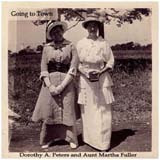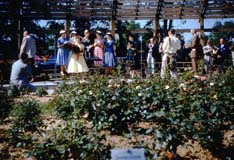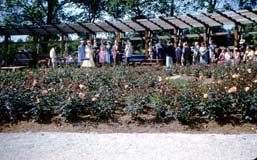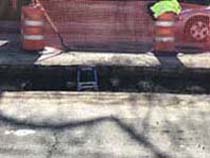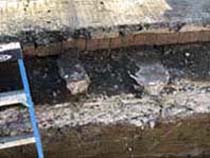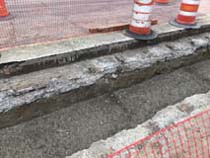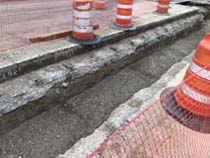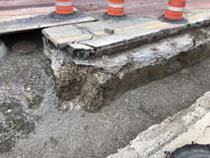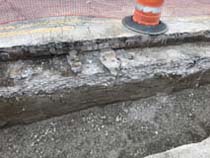‘1940-present’ Category
Ghosts of Clintonville–Ghostbusted by Google Earth
Wednesday, October 30th, 2019There are several old residential buildings that have disappeared over the last 12 years–I wish we had photos of them.
 The old Hollenback home and The Booster building, located at California and North High Streets. I remember this building setting back over a slight rise from North high Street. This is a Google Earth image from 2004 of the roofs of these buildings.
The old Hollenback home and The Booster building, located at California and North High Streets. I remember this building setting back over a slight rise from North high Street. This is a Google Earth image from 2004 of the roofs of these buildings.
 A large Victorian house demolished to make way for the commercial building presently occupied by Lavash Restaurant. This is the Google image from 2004 of the rooftop.
A large Victorian house demolished to make way for the commercial building presently occupied by Lavash Restaurant. This is the Google image from 2004 of the rooftop.
 Another big old residential building, this one located on Weber, one building east from North High Street on the north side of Weber. (Another Google image from 2004.) I’m not sure but believe this building was built for and owned by a member of the Armbruster family, whose patriarch lived in what became Southwick-Good-Fortkamp funeral home. You will find lots of additional information about Mathias Armbruster on my web site.
Another big old residential building, this one located on Weber, one building east from North High Street on the north side of Weber. (Another Google image from 2004.) I’m not sure but believe this building was built for and owned by a member of the Armbruster family, whose patriarch lived in what became Southwick-Good-Fortkamp funeral home. You will find lots of additional information about Mathias Armbruster on my web site.
E. A. Fuller Farm
Monday, September 2nd, 2019The Clintonville Historical Society October 2017 monthly newsletter contained an interesting article about the land at the Clintonville Women’s Club by Mary Rodgers.
________
The Clintonville Woman’s Club: The Women Before the Clubhouse
by Mary Rodgers
I was asked to speak at an evening meeting of the Clintonville Woman’s Club. Specifically, I was asked to speak on the subject of the history of the land that the Clubhouse occupies. I have always understood that the Clubhouse was located on land from the old Fuller Farm. I was surprised to learn more about the “Fuller” family.
In the 1820s, John Rathbone sold farm lot 5 to Edward Amaziah Stanley. Using today’s landmarks, that land would have been bounded on the east by Indianola Avenue, on the west by the river, on the south by roughly Torrence Road and on the north by roughly Overbrook Drive. When Mr. Stanley died in 1862, his land holdings were passed down to his children. Harriet Marie Stanley (aka Hattie) was one of those children. She was born in Connecticut in 1831. Based on the extensive land holdings throughout Ohio, I believe her father Edward was an Ohio land speculator. After acquiring several thousand acres, in 1829, he returned to Connecticut to marry Abagail Talcott Hooker. Sometime between 1831 and 1834, the family moved to the Clintonville area.
In 1856, Hattie married Erskine Asa Fuller, aka E. A. Fuller. E. A. has known as a dealer in stock animals. When her father passed away, Hattie inherited all of farm lot 5 in Clinton Township Ohio. The 1870 census shows a large extended family living together in Clintonville. The Fullers and their daughters, Hattie’s mother, brother, sister and several farm hands and servants. The combined household value per that census was in excess of $25,000. Hattie passed away in 1879. E.A. passed away in 1894. After their deaths, the farm was transferred equally to the four Fuller daughters–Abby, Mary, Katherine and Martha. Martha Fuller and her sister Katherine Fuller Peters lived all of their lives in Clintonville. They owned two brick homes along High Street; Katherine’s was just south of where the Library sits today and Martha’s was where the Christian Science church sits today. Martha Fuller passed away in 1938. She left half of her land holdings to long time farm hand Matthew McCallen and half to her niece (sister Mary’s daughter) Helen Osborn. Eventually, all the land was sold off, some to the Christian Science Church, and some to the Calvary Bible Church and the balance to the City of Columbus. The lane where the Clintonville Woman’s Club land is located was purchased by the Kiwanis Club of Northern Columbus. That Club loaned the ladies the funds needed to build the Clubhouse. In turn, they held a mortgage on the property. The Woman’s Club members worked tirelessly and retire their debt to the Kiwanis within five short years! They have owned the Club house and property ever since.
A Rose Is a Rose Is a Rose Is a Rose…
Thursday, May 30th, 2019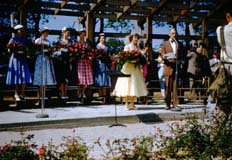 Joyce Ailes Schatz shared some wonderful Maiden of the Roses treasures with us. The photos were taken by her dad, Howard Ailes, on May 30, 1954, and they are of that year’s Maiden of the Roses pageant. The winner that year was Nancy Blanchard (later, Mrs. Clyde Graham). Nancy is Joyce’s cousin.
Joyce Ailes Schatz shared some wonderful Maiden of the Roses treasures with us. The photos were taken by her dad, Howard Ailes, on May 30, 1954, and they are of that year’s Maiden of the Roses pageant. The winner that year was Nancy Blanchard (later, Mrs. Clyde Graham). Nancy is Joyce’s cousin.
Nancy attended Mifflin High School, which in 1954 was a county school and located on Sunbury Road near Agler Road. Nancy was born April 23, 1938 in Columbus, and died May 10, 2018. [Images courtesy of Joyce Schatz]
You can read more about this pageant here.
 In these images, Queen Nancy is joined by her court, Ruthann Limotta, Carol Newhouse, Dorothy Corfee, Charlene McNair, & Louise Winzenreid (in unknown order). The court’s other member was Barbara Harder, but she does not appear in the picture. Does anyone know who the man is?
In these images, Queen Nancy is joined by her court, Ruthann Limotta, Carol Newhouse, Dorothy Corfee, Charlene McNair, & Louise Winzenreid (in unknown order). The court’s other member was Barbara Harder, but she does not appear in the picture. Does anyone know who the man is? 

In the next two images of the queen and her court, we are not sure who the two extra women are.

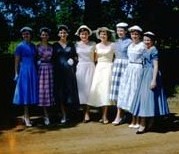
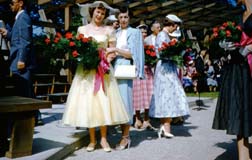 Nancy and her mother, Mrs. Bernice (Ailes) Blanchard. Bernice was the photographer’s sister.
Nancy and her mother, Mrs. Bernice (Ailes) Blanchard. Bernice was the photographer’s sister.
In the next three images: Mayor of Columbus Jack Sensenbrenner, Mrs Jane Lausche (wife of Ohio Governor Frank Lausche), and Ray McNamara (Ohio Director of the American Rose Society)
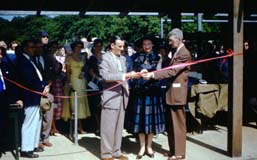
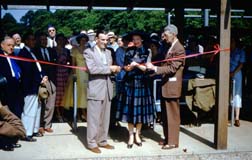
Nancy Blanchard and her court, and Ray McNamara, Ohio Director of the American Rose Society.

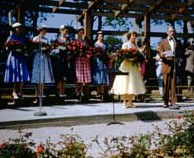
And a few more from Joyce’s treasure trove of pictures.
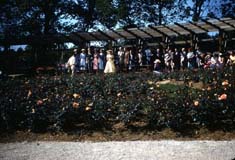
250 East North Broadway
Sunday, May 12th, 2019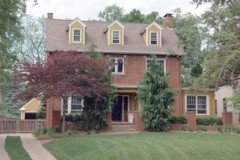 Another beautiful house on East North Broadway is on the market: 250 East North Broadway. Here, courtesy of realtor Judy Minister, is a video tour of the house.
Another beautiful house on East North Broadway is on the market: 250 East North Broadway. Here, courtesy of realtor Judy Minister, is a video tour of the house.
According to Mary Rodgers, the house was built in 1927 at an original cost of $8,320. The first owner of the home was Vera Hults Benoy. Her husband Wilbur was an attorney. He graduated from Ohio State University and was admitted to the bar in 1910. He served as City Attorney, County Prosecutor, and as Special Assistant to the Ohio Supreme Court. He had some fairly large legal cases, including the 1926 prosecution of the Mayor of Grove City for race track betting. Later, he maintained an office in the AUI building (now the LeVeque Tower).
Wilbur was raised in Licking Co. His father owned a grocery in Croton. Wilbur’s mother died in a car accident in Columbus in 1921. Vera was born in Delaware, Ohio. Prior to her marriage in 1912, Vera was a school teacher.
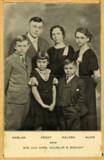 Wilbur and Vera had four children: Alice, Harlan, Ellen (aka Peggy) and Halden. Their daughter Alice was a music teacher.
Wilbur and Vera had four children: Alice, Harlan, Ellen (aka Peggy) and Halden. Their daughter Alice was a music teacher.
[Information and family photograph courtesy of Mary Rodgers, Clintonville Historical Society.]
Hudson & Cleveland, or Elsewhere (Updated)
Monday, April 22nd, 2019 This picture was labelled, in cursive, “Looking North at the Corner of Hudson and Cleveland.” It was obviously taken April 22, 1948 on State Route 3. The buildings in the photograph, however, don’t match the buildings that are there today–I’m especially eyeing that two story pre-WW II brick building on the left–so I’m doubtful it is that intersection. Any ideas about its location?
This picture was labelled, in cursive, “Looking North at the Corner of Hudson and Cleveland.” It was obviously taken April 22, 1948 on State Route 3. The buildings in the photograph, however, don’t match the buildings that are there today–I’m especially eyeing that two story pre-WW II brick building on the left–so I’m doubtful it is that intersection. Any ideas about its location?
[Image courtesy of Galen Gonser.]
Michael Leyshon believes the photo may be looking south from Weber, where Cleveland/Westerville Roads split (see his comment below). Perhaps so! That intersection has an interesting corner curve, but I’m not convinced. I drove up and down the street today, and am not seeing that brick building (with its distinctive roof line) to the left in the photo. Travelling northbound from Hudson, between Hudson and Weber, there IS an old brick 2-story building on the west side of the street, that is now clad in white. That very old, virtually decrepit, building has the only roof line close in appearance, though it seems short compared to the building in the photo. I continue to welcome ideas. Thanks Michael!
See comments below. John Williamson reposted Galen’s photo to the Vintage Columbus–Linden Area Facebook Page, and asked those folks for their expertise and/or memories. Bob Roehrer found a 1953 aerial, shown below, that seems to confirm the wide, rounded curb cut at Hudson & Cleveland, shown in Galen’s 1948 photo.
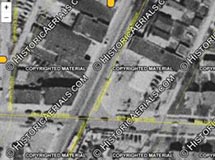
West Orchard Lane and North High Street
Monday, January 14th, 2019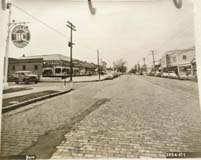 A lovely picture of the street at the intersection of West Orchard Lane and North High Street, looking north by northwest, on January 14, 1947. A Sinclair Station was located at the location of the current Donato’s Pizza, and Moore’s Auto Parts was where Momentum Natural Health Store is today. Gray’s Cut Rate Drug Store was next to Moore’s.
A lovely picture of the street at the intersection of West Orchard Lane and North High Street, looking north by northwest, on January 14, 1947. A Sinclair Station was located at the location of the current Donato’s Pizza, and Moore’s Auto Parts was where Momentum Natural Health Store is today. Gray’s Cut Rate Drug Store was next to Moore’s.
[Image courtesy of Galen Gonser]
Smith’s Skating Rink
Thursday, November 15th, 2018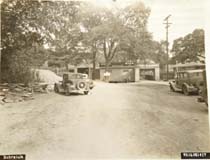 This is not Clintonville! But it is close enough that folks in the Clintonville neighborhood would surely have frequented it.
This is not Clintonville! But it is close enough that folks in the Clintonville neighborhood would surely have frequented it.
George W. Smith, a well-known Columbus dancing instructor, built Smith’s Iuka Dance Gardens around 1903. Two seasons later, Smith and his wife opened Smith’s Skating Rink, a roller skating rink.
Both establishments were located at 2150 North Fourth Street in Columbus, Ohio, until they closed in 1971.
George Willard Smith is interred in Greenlawn Abbey, and here is an excerpt about George and his wife Adele Green Smith from the Abbey’s web site:
Abbey resident George Willard Smith was known as the “King of the Outdoor Amusements” in the early days of the 20th century. He certainly didn’t start out that way. He was born on Christmas day, in 1860, in Syracuse, New York. His parents, John and Fannie Smith, were hard working blue collar kind of people. The family would make their way to Columbus in 1872 and John would find a job as a salesman. (The directories of the time list him as a “peddler”.) A few years later around 1875, George would join in with his father to help with rent and bills and they both would be carriage trimmers by the late 1870’s. Carriage trimmers were responsible for upholstering the seats, floors and roofs of buggies, and the Columbus Buggy Company was a large manufacturer in the city, employing well over 1,000 people by 1880. Work was so efficient, that they finished a buggy every 8 minutes on average. John would pass away in early 1882 at the age of 50, and which must’ve struck a chord in 22 year old George, with him not wanting to die young laboring away like his father did. It’s clear that George had another plan in mind. In those days it was very common to learn dance instruction by reading a book, as private lessons were expensive. Society minded people were getting waltz lessons and trying to be more genteel. George never spoke of any dance schools he attended, so the likely explanation as to how he learned and then taught dancing lessons was he got one of these books as well. (“The Universal Dancing Master,” written by Lucien Carpenter, was popular book published in the same year of John Smith’s death.) Although he was listed as still being a carriage trimmer until 1893, George started a “Home Academy of Dance” in 1894, giving himself the title of professor and calling himself a dancing master.
It’s not known how long Smith was courting Adele Green, daughter of William J. Green, a local Columbus physician. It’s possible that Adele, born in Knox county in 1880, was a student of George’s and he took a shine to her. George was 40 in 1900, Adele was 20, and they both shared an interest in dancing. It could also be that her father was a member of the Benevolent and Protective Order of the Elks, just like George was, and they were introduced to each other through that. Smith wasn’t an old man by any means, and even though it may look a little odd today, marrying a man many years older than her was a normal thing for a woman to do then. The age difference didn’t seem to matter to them much and they were married in 1902.
Smith actually had an article in the Columbus Dispatch claiming that he taught 26,000 people how to dance, and that he was going to officially retire from teaching his home dancing classes. He would still own them for several years, but would employ instructors. His big break was that he was able to lease some land from the Neil family in the area of Iuka Ravine where Northwood and 4th is today for a dance pavilion. A few years later, in 1905, there would also be a roller skating rink on the same property, which George named “Smith’s Iuka Park Gardens.” Roller skating competitions would be held in the rink, where the best skaters in the state would compete to see who could skate the fastest laps.1909 was the biggest year for such a competition.
George had enough money by this time to own and operate the B. F. Keith Theater on Gay Street, a vaudeville theater. His in laws lived in an apartment on the floors above the theater itself, and that’s also where Smith had his office…
As the teens waned and the 20’s came roaring, George and Adele would do less with the theater work and spend more time on their more profitable dance hall and skating rink ventures. Iuka Park Gardens became an institution for the community, even employing boys as young as 12 years old to help lace up the skate to the shoes of the patrons. Several people would meet their sweethearts for the first time at the rink, get their first kisses, and engagements there over the years. The Smith’s employees loved them and some would stay employed by them for decades. George’s brother in law Ivan would help run the business in 1938, and George would pass away in 1948. Adele would continue Iuka Park Gardens until her death in 1965, and it would remain open until Ivan had to close the business in 1971. The land was sold, the dance hall and rinks bulldozed, and the Iuka Park Commons apartments are there to this day. The Smiths had no children.
[Image courtesy of Galen Gonser}
Under Indianola
Friday, June 15th, 2018John Krygier recently sent me the following photos (shown across then down), taken May 2018, with accompanying information:
When the City contractor dug down to put the new median (with trees, plants) on Indianola Ave. by Studio35, I took a few photos of the road subsurface and they can be found here.
The construction of the road was rather interesting. Like many other Clintonville streets, Indianola has brick
pavers under the asphalt.If you look at the photos you will notice that train rails are running perpendicular to the road, and seem to have been used to reinforce the road from below…
I’m wondering if the rails were scrapped from the rail spur that came in from the main line, through Glen Echo (the north side of the ravine) to the old sewer pipe factory (now the site of Columbus International High School).
The cross-section of the roads seems to be (from top down):
Asphalt (newer)
Pavers
Concrete
SoilAlso, here is a PDF about early 20th century street construction in Cleveland, which seems similar to our city streets constructed at the time.
And here is an article about resurfacing roads in Columbus.
Thanks John!
Elford Company Develops Beechwold
Tuesday, May 1st, 2018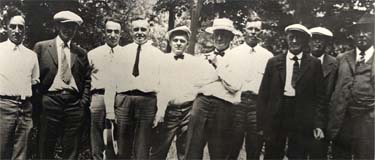
Elford Inc., a commercial construction company located near Grandview on Dublin Road, celebrated its 100th anniversary in 2010.
To mark the occasion, the company published a 70-page hardcover book detailing Elford’s history, from its founding by Edward “Pop” Elford in 1910 to today. It’s available as a PDF here. The book chronicles the company’s history decade by decade, focusing on the marquee projects of each decade.
From a Clintonville and Beechwold perspective, the following are standouts:
[PDF booklet courtesy of Elford by way of Wendy Bayer.]

